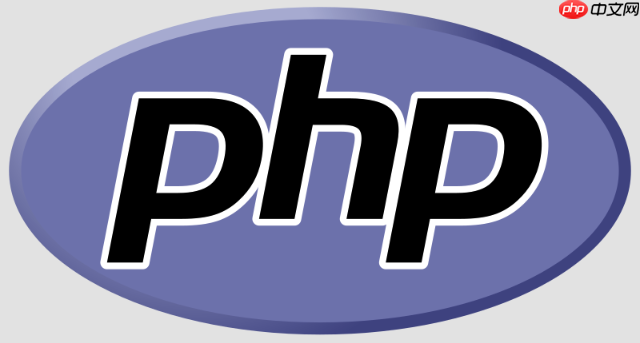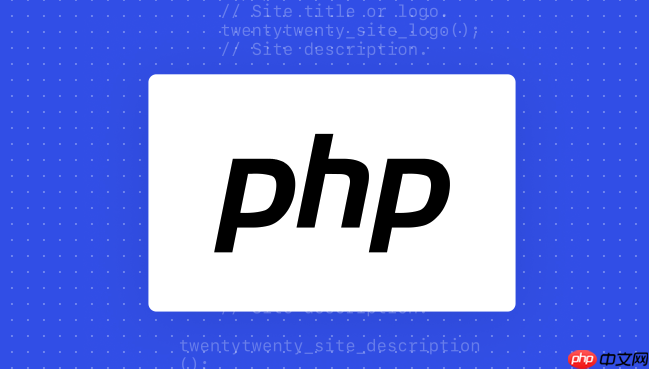 Backend Development
Backend Development
 PHP Tutorial
PHP Tutorial
 How to configure Windows 11 firewall to allow PHP services PHP port open and secure settings
How to configure Windows 11 firewall to allow PHP services PHP port open and secure settings
How to configure Windows 11 firewall to allow PHP services PHP port open and secure settings
Jul 23, 2025 pm 06:27 PMTo allow PHP services to pass through the Windows 11 firewall, you need to create inbound rules to open the corresponding port or program. 1. Determine the port that PHP is actually listening. If the built-in server is started with php -S localhost:8000, the port is 8000, and if using Apache or IIS, it is usually 80 or 443. 2. Open the advanced settings of "Windows Defender Firewall", create a new inbound rule, select "Program" or "Port", fill in the PHP or Web server path or specify the port number. 3. Select Allow Connections, check the applicable network profile, name the rules and add a description. The IP addresses that are allowed to access, such as local network or specific IP, can be restricted through the scope. In terms of security, the system should be updated, HTTPS should be used, the rules should be reviewed regularly, and the WAF protection should be deployed. If the rule does not take effect, you can check the rule's activation status, priority, and port occupation, temporarily disable firewall testing or view firewall log location issues.

Allowing PHP services to pass through Windows 11 firewall is the core of configuring inbound rules, opening up the ports used by PHP (usually 80 or 443, if using a built-in web server), while taking into account security and avoiding the risks caused by overopening.

To configure Windows 11 firewall to allow PHP services, you need to create inbound rules that allow PHP processes or their web servers (such as built-in PHP development servers or IIS) to pass through the firewall. At the same time, it is also necessary to consider the security of port opening to avoid unnecessary risks.
How to find the actual running port of PHP?
First, it is crucial to determine the port that PHP actually listens for. If you are using a PHP built-in development server, you can find the port number in the startup command, such as php -S localhost:8000 , where 8000 is the port number. If PHP is running through a web server like IIS or Apache, the port is usually the standard 80 (HTTP) or 443 (HTTPS). Check the configuration file of the web server to confirm the specific port settings. For example, in Apache's httpd.conf file, you can find configurations like Listen 80 .

Steps to Create Windows Firewall Inbound Rules
Open Windows Defender Firewall and select Advanced Settings. In the left panel, click "Inbound Rules", and then click "New Rules..." in the right panel. In the New Inbound Rule Wizard, select Programs or Ports. If you select "Program", you need to find the path to the PHP interpreter (php.exe) or web server (such as httpd.exe or w3wp.exe). If "Port" is selected, select TCP protocol and enter the port number of the PHP listening. Next, select "Allow connections". On the Profile page, select the profiles for your network (usually Domain, Dedicated, and Public). Finally, name and add a description for future management.
How to restrict access to PHP services in a specific IP address?
While open ports are necessary, security can be improved by limiting the IP addresses that are allowed to access. When creating an inbound rule, you can specify the range of IP addresses that allow connections in the Scope tab. For example, you can only allow access to local networks (such as 192.168.1.0/24) or specific IP addresses. For more advanced controls, consider using the access control features of the web server, such as Apache's .htaccess file or IIS's IP address and domain restriction features.

Security considerations for port opening
Open ports are always accompanied by security risks and therefore need to be treated with caution. In addition to restricting IP addresses, the following measures can also be considered:
- Keep PHP and web server updated: Installing security patches in time can fix known vulnerabilities.
- Using HTTPS: Encrypt communication through SSL/TLS to protect the security of data during transmission.
- Regularly review firewall rules: check for unnecessary rules and clean them up in time.
- Using Web Application Firewall (WAF): WAF can detect and block malicious traffic, providing additional security protection.
How to troubleshoot the problem that the firewall rules do not take effect?
If a firewall rule is created but the PHP service is still inaccessible, you can try the following method to troubleshoot:
- Check if the rule is enabled: Make sure the rule you created is enabled.
- Check the priority of rules: Firewall rules are executed in order of priority to ensure that your rules are not overwritten by other rules.
- Check whether the port is occupied: Use the
netstat -anocommand to see if the port is occupied by other programs. - Temporary firewall disable: Temporary firewall disable temporarily to see if it is a problem caused by the firewall. If it is accessible after disable, it means that the problem is indeed in the firewall configuration.
- View the firewall log: Windows firewall can record blocked connections, and viewing the log can help you find the problem.
Configuring a firewall is a process that requires careful consideration of security factors. Proper configuration ensures that PHP services are operating properly while minimizing security risks.
The above is the detailed content of How to configure Windows 11 firewall to allow PHP services PHP port open and secure settings. For more information, please follow other related articles on the PHP Chinese website!

Hot AI Tools

Undress AI Tool
Undress images for free

Undresser.AI Undress
AI-powered app for creating realistic nude photos

AI Clothes Remover
Online AI tool for removing clothes from photos.

Clothoff.io
AI clothes remover

Video Face Swap
Swap faces in any video effortlessly with our completely free AI face swap tool!

Hot Article

Hot Tools

Notepad++7.3.1
Easy-to-use and free code editor

SublimeText3 Chinese version
Chinese version, very easy to use

Zend Studio 13.0.1
Powerful PHP integrated development environment

Dreamweaver CS6
Visual web development tools

SublimeText3 Mac version
God-level code editing software (SublimeText3)

Hot Topics
 Building Immutable Objects in PHP with Readonly Properties
Jul 30, 2025 am 05:40 AM
Building Immutable Objects in PHP with Readonly Properties
Jul 30, 2025 am 05:40 AM
ReadonlypropertiesinPHP8.2canonlybeassignedonceintheconstructororatdeclarationandcannotbemodifiedafterward,enforcingimmutabilityatthelanguagelevel.2.Toachievedeepimmutability,wrapmutabletypeslikearraysinArrayObjectorusecustomimmutablecollectionssucha
 css dark mode toggle example
Jul 30, 2025 am 05:28 AM
css dark mode toggle example
Jul 30, 2025 am 05:28 AM
First, use JavaScript to obtain the user system preferences and locally stored theme settings, and initialize the page theme; 1. The HTML structure contains a button to trigger topic switching; 2. CSS uses: root to define bright theme variables, .dark-mode class defines dark theme variables, and applies these variables through var(); 3. JavaScript detects prefers-color-scheme and reads localStorage to determine the initial theme; 4. Switch the dark-mode class on the html element when clicking the button, and saves the current state to localStorage; 5. All color changes are accompanied by 0.3 seconds transition animation to enhance the user
 How to assign a drive letter in Windows
Jul 30, 2025 am 04:54 AM
How to assign a drive letter in Windows
Jul 30, 2025 am 04:54 AM
ToassignadriveletterinWindows,useDiskManagementorCommandPrompt.2.InDiskManagement,pressWindows X,selectDiskManagement,right-clickthevolumewithoutaletter,choose"ChangeDriveLetterandPaths",clickAdd,selectaletter(avoidA:orB:),andclickOK.3.Alte
 How to find the installation date of Windows
Jul 30, 2025 am 04:57 AM
How to find the installation date of Windows
Jul 30, 2025 am 04:57 AM
UseCommandPromptbytypingsysteminfo|find"OriginalInstallDate"toinstantlyseetheoriginalWindowsinstallationdate.2.Alternatively,usePowerShellwith(Get-ItemProperty-Path"HKLM:\SOFTWARE\Microsoft\WindowsNT\CurrentVersion").InstallDatean
 How to create a system image in Windows
Jul 30, 2025 am 04:57 AM
How to create a system image in Windows
Jul 30, 2025 am 04:57 AM
OpenBackupandRestoreviaWindows S,typeBackupandRestore,clickCreateasystemimage.2.Savetheimagetoanexternalharddrive(recommended),selectitfromthedropdown,andclickNext.3.Confirmincludeddrives(systemreservedandC:bydefault),addothersifneeded,thenclickNext.
 VSCode settings.json location
Aug 01, 2025 am 06:12 AM
VSCode settings.json location
Aug 01, 2025 am 06:12 AM
The settings.json file is located in the user-level or workspace-level path and is used to customize VSCode settings. 1. User-level path: Windows is C:\Users\\AppData\Roaming\Code\User\settings.json, macOS is /Users//Library/ApplicationSupport/Code/User/settings.json, Linux is /home//.config/Code/User/settings.json; 2. Workspace-level path: .vscode/settings in the project root directory
 How to set up an FTP server in Windows
Jul 30, 2025 am 04:02 AM
How to set up an FTP server in Windows
Jul 30, 2025 am 04:02 AM
InstallIISandFTPcomponentsviaWindowsFeatures,ensuringFTPService,FTPExtensibility,andIISManagementConsoleareenabled.2.CreateadedicatedFTPfolder(e.g.,C:\FTP),grantIIS_IUSRSModifypermissions,andoptionallyaddspecificusers.3.InIISManager,addanFTPsitebyspe
 Sublime Text auto close HTML tags
Jul 30, 2025 am 02:41 AM
Sublime Text auto close HTML tags
Jul 30, 2025 am 02:41 AM
Installing the Emmet plug-in can achieve intelligent automatic closing of tags and support abbreviation syntax; 2. Enable "auto_match_enabled":true to allow Sublime to automatically complete simple tags; 3. Use Alt . (Win) or Ctrl Shift . (Mac) shortcut keys to manually close the current tag - it is recommended to use Emmet in daily life. The latter two methods can be combined, which is efficient and simple to set.





